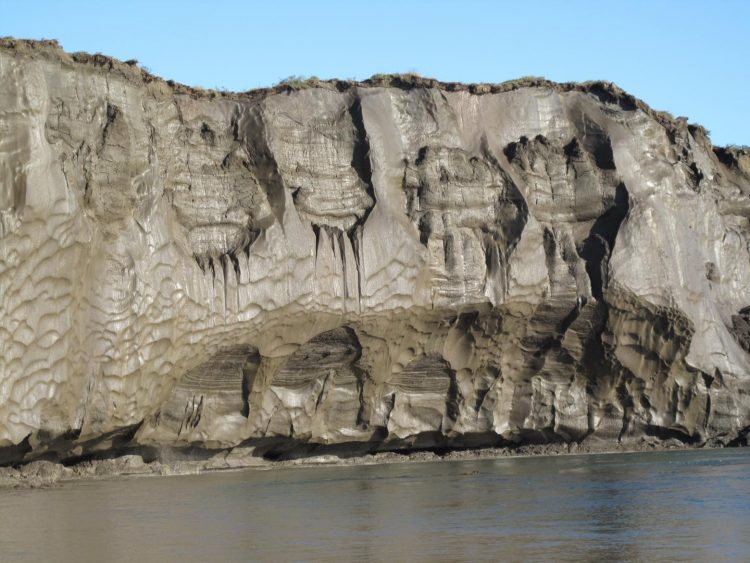Ancient permafrost quickly transforms to carbon dioxide upon thaw

This is a general view of a 35-meter-high riverbank exposure of the ice-rich syngenetic permafrost (yedoma) containing large ice wedges along the Itkillik River in northern Alaska. Photo courtesy Mikhail Kanevskiy; University of Alaska Fairbanks, Institute of Northern Engineering
Huge stores of organic carbon in permafrost soils — frozen for hundreds to tens of thousands of years across high northern latitudes worldwide — are currently isolated from the modern day carbon cycle.
However, if thawed by changing climate conditions, wildfire, or other disturbances, this massive carbon reservoir could decompose and be emitted as the greenhouse gases carbon dioxide and methane, or be carried as dissolved organic carbon to streams and rivers.
“Many scientists worldwide are now investigating the complicated potential end results of thawing permafrost,” said Rob Striegl, USGS scientist and study co-author.
“There are critical questions to consider, such as: How much of the stored permafrost carbon might thaw in a future climate? Where will it go? And, what are the consequences for our climate and our aquatic ecosystems?”
At a newly excavated tunnel operated by the U.S. Army Corps of Engineers near Fairbanks, Alaska, a research team from USGS, CU-Boulder and and Florida State University set out to determine how rapidly the dissolved organic carbon from ancient (about 35,000 years old) “yedoma” soils decomposes upon soil thaw and how much carbon dioxide is produced.
Yedoma is a distinct type of permafrost soil found across Alaska and Siberia that accounts for a significant portion of the permafrost soil carbon pool. These soils were deposited as wind-blown silts in the late Pleistocene age and froze soon after they were formed.
“It had previously been assumed that permafrost soil carbon this old was already degraded and not susceptible to rapid decomposition upon thaw,” said Kim Wickland, the USGS scientist who led the team.
The researchers found that more than half of the dissolved organic carbon in yedoma permafrost was decomposed within one week after thawing. About 50 percent of that carbon was converted to carbon dioxide, while the rest likely became microbial biomass.
“What this study adds is that we show what makes permafrost so biodegradable,” said Travis Drake, the lead author of the research. “Immediately upon thaw, microbes start using the carbon and then it is sent back into the atmosphere.” Drake was both a USGS employee and a master's degree student at CU-Boulder during the investigation.
The researchers attribute this rapid decomposition to high concentrations of low molecular weight organic acids in the dissolved organic carbon, which are known to be easily degradable and are not usually present at high concentrations in other soils.
These rates are among the fastest permafrost decomposition rates that have been documented. It is the first study to link rapid microbial consumption of ancient permafrost soil-derived dissolved organic carbon to the production of carbon dioxide.
An important implication of the study for aquatic ecosystems is that dissolved organic carbon released by thawing yedoma permafrost will be quickly converted to carbon dioxide and emitted to the atmosphere from soils or small streams before it can be transported to major rivers or coastal regions.
###
Co-authors on the study include CU-Boulder Professor Diane McKnight and Florida State University faculty member Robert Spencer. McKnight is affiliated with the Center for Water, Earth Science and Technology (CWEST) in CU-Boulder's Institute of Arctic and Alpine Research. CWEST is a partnership of CU-Boulder and the USGS.
The research was recently published in the Proceedings of the National Academy of Sciences. The National Science Foundation's Division of Polar Programs provided essential support for the investigation.
Contact:
Jon Campbell, USGS, 703-648-4180
jon.campbell@usgs.gov
Kim Wickland, 303-541-3072
kpwick@usgs.gov
Jim Scott, CU media relations, 303-492-3114
jim.scott@colorado.edu
Media Contact
All latest news from the category: Earth Sciences
Earth Sciences (also referred to as Geosciences), which deals with basic issues surrounding our planet, plays a vital role in the area of energy and raw materials supply.
Earth Sciences comprises subjects such as geology, geography, geological informatics, paleontology, mineralogy, petrography, crystallography, geophysics, geodesy, glaciology, cartography, photogrammetry, meteorology and seismology, early-warning systems, earthquake research and polar research.
Newest articles

A ‘language’ for ML models to predict nanopore properties
A large number of 2D materials like graphene can have nanopores – small holes formed by missing atoms through which foreign substances can pass. The properties of these nanopores dictate many…

Clinically validated, wearable ultrasound patch
… for continuous blood pressure monitoring. A team of researchers at the University of California San Diego has developed a new and improved wearable ultrasound patch for continuous and noninvasive…

A new puzzle piece for string theory research
Dr. Ksenia Fedosova from the Cluster of Excellence Mathematics Münster, along with an international research team, has proven a conjecture in string theory that physicists had proposed regarding certain equations….



